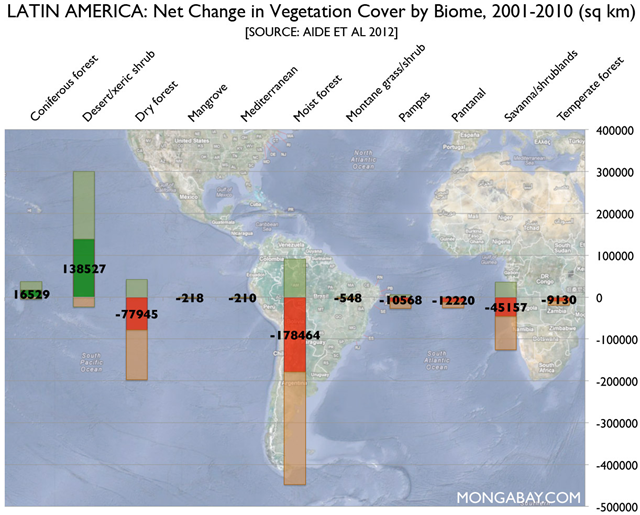Graph of the Day: Change in Vegetation Cover by Biome across Latin America, 2001-2010
By Rhett A. Butler, www.mongabay.com
20 August 2012 Latin America lost nearly 260,000 square kilometers (100,000 square miles) of forest — an area larger than the state of Oregon — between 2001 and 2010, finds a new study [pdf] that is the first to assess both net forest loss and regrowth across the Caribbean, Central and South America. The study, published in the journal Biotropica by researchers from the University of Puerto Rico and other institutions, analyzes change in vegetation cover across several biomes, including forests (dry, temperate, moist, mangroves and coniferous), grasslands (pampas, shrublands, montane grasslands, savanna, desert/xeric shrublands), and wetlands (pantanal). It finds that the bulk of vegetation change occurred in forest areas, mostly tropical rainforests and lesser-known dry forests. The largest gains in woody vegetation area occurred in desert vegetation and shrublands. Gross deforestation amounted to 542,000 sq km, while recovery of woody vegetation occurred across 362,000 sq km. Argentina experienced the largest net loss across all biomes, losing 101,734 square kilometers, mostly in the form of dry forests (67,140 sq km) and grasslands (15,729 sq km). Brazil followed with a loss of 99,424 sq km, primarily in the form of moist forests (145,511 sq km). Brazil had the highest gross loss of vegetation cover during the period (245,767 sq km), but that was partly offset by the highest gross gain (146,342 sq km). Mexico had the largest net increase in biome area at 96,089 sq km mostly due to a rise in land classified as “desert/xeric shrub” cover (79,085) and regrowth of dry forests (12,810) and coniferous forest (11,907 sq km). The study is based on assessment of NASA MODIS satellite data for some 16,000 municipalities across Latin America and the Caribbean. It excludes plantations and large-scale agricultural areas. Overall the paper found that 80 percent of deforestation occurred in just four countries — Brazil, Argentina, Paraguay, and Bolivia — and was most closely associated with export-oriented agriculture. “A key factor contributing to deforestation in South America is the increasing global demand for meat products, which has intensified land clearing for grazing and large-scale agriculture,” said lead author Mitchell Aide of the University of Puerto Rico. “Beef exports have increased dramatically, and there has also been a boom in soybean production. These soybeans are not for tofu or soy milk, but pig and poultry feed in China and Europe.” […]
Chart: Forest loss in Latin America
